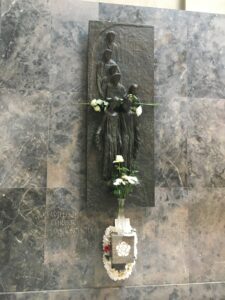How was the White Rose commemorated after the war, and do we find different kinds of commemoration in the German Democratic Republic and the Federal Republic of Germany?
The White Rose members’ courageous stance against the Nazi Regime had an impact on all of Germany, not just immediately after the deaths, but throughout the ensuing post-war decades. Their legacy lives on today, in streets, squares, plaques, and buildings bearing their names. Even an asteroid has been named after the White Rose, Asteroid 7571 Weiße Rose. Between 1945 and 1989, the White Rose group was commemorated on either side of the Berlin Wall. Unsurprisingly, a different approach was taken in the East and the West.
In the former East Germany, Sophie is the focus of commemoration. One example comes in the form of a sewing brigade as reported in January of 1960 in Neues Deutschland, an East German newspaper. The article, entitled “A pledge to quality: Seamstress brigade is publicly accountable”, reports that the 41 seamstresses from the youth master division in the Thuringian clothing factory in Erfurt were known under the division name of “Sophie Scholl”. The division was responsible for making “first quality” clothing at a 99.5 percent rate. Although we do not know if they chose their own division name, these young women seem to have connected the idea of someone who is willing to do the utmost for their country, like Sophie Scholl, to their own work.
We find another example of this is an article in Neues Deutschland from February 4, 1960. It records the Central Committee’s theses on the importance of International Women’s Day to women around the world. Although the piece is centered on the role of women within the German Democratic Republic, it also references women who were part of a memorial in Ravensbrück to commemorate their roles in furthering peace and progress. Lilo Herrmann, Katja Niederkirchner, Hilde Coppi, Judith Auer, Olga Benario, and Mildred Harnack were all executed by the Nazi Regime for their involvement with Communism. Perhaps surprisingly, though, one of the names included is Sophie Scholl. Why was she included with members of the KPD (the Communist Party of Germany) when she could hardly have been called a communist? Like them, though, her actions sought to contribute to the furthering of peace and progress. And, like her comrades, she asked the people of Germany through the White Rose leaflets to participate in resistance. And, like these other women, she died for her cause. The article is a striking piece of propaganda, supporting the GDR state, but also paying a perhaps surprising tribute to Sophie Scholl.

in the main building at the Ludwig-Maximilians-Universität, Munich.
In West Germany, we find a focus on commemorating the White Rose group as a whole. Many monuments, streets and memorials were created or renamed to commemorate individuals that participated in the White Rose resistance. One such site is Munich University where multiple memorials of the group can be found. There are the squares outside the main university building which were renamed in 1946 as Kurt-Huber-Platz and Geschwister-Scholl-Platz. In addition, there is a bronze relief plaque of the White Rose group in the university’s main hall. Placed there in 1958, it includes not only the six central members of the White Rose in Munich, but also Hans Leipelt who was executed for his part in the resistance in January 1945. More information on the memorials in and around the university is available in German and in English.

More research is needed to fully grasp the differences between commemoration in post-war East and West Germany. However, what does seem to emerge from the work I have done on this topic is that there was a fixed interest in keeping the memory of the White Rose alive on either side of the Berlin Wall. Commemoration itself can be complicated, as each act of commemoration inevitably reflects the time and place where it occurs. Still, these acts can be useful for academics to gain further understanding about those who drive and enact commemoration and commemorative practices.
Katie J. Sanchez is a Pennsylvania State University undergraduate in her senior year. She majors in Digital Multimedia Design and minors in History. During her time as a visiting student at Oxford (2019-2020), her research focused on women’s experience in the Weimar Republic and Nazi Germany. She also is interested in the history of the Americas and the Greater Caribbean.